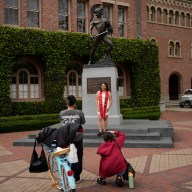 “City as Canvas” runs through Aug. 24 (www.mcny.org).
“City as Canvas” runs through Aug. 24 (www.mcny.org).
Credit: Liz Ligon
Few New Yorkers hustling on the mean streets of 1970s and ’80s considered it to be the “golden age” of anything. The Bronx was burning, Times Square was peeping and the Lower East Side was sinking in blight. Among the grit, a new sprayable voice of the street emerged: graffiti art.
With the recent destruction of 5Pointz and subsequent Banksy invasion, New Yorkers have lately been questioning the role of graffiti art today inthe city that invented it. The Museum of the City of New Yorkleads the discussion withits new exhibition “City as Canvas,” which looks at the ascent of this craft during the decades that shaped it.
Reviled by most at the time as the festering of urban decay, graffiti art found support in a few savvy artists like Martin Wong, who began collecting hundreds of mixed-media paintings — on canvas, cardboard, paper and plywood — by the leading artists of the day. Prior to his death in 1999 from AIDS, he entrusted his collection to the museum.
“City as Canvas” has 150 pieces on display, several of which go back to the early days of the graffiti art movement. “Wicked Gary’s Tag Collection” (1970-1972) displays a mosaic of 70 ink-drawn “tags” by early ’70s graffiti artists like PHASE 2, COCO 144 and SNAKE I.
Keith Haring’s whimsical untitled subway work remains as fun as ever, but there’s more magic in “Transition” (1982), a work by Christopher Ellis, aka DAZE, which celebrates his days painting subway cars. Another of his, “Amazon Hotel,” (1988), thrills with its kinetic squirm of a summer house party (Flavor Flav in attendance). The quality of such work provides all the more punch to the declaration in “Howard the Duck” (1988) by Lee Quinones, aka LEE: “Graffiti is a art and if art is a crime, let God forgive all.”
Nostalgia begins to grip at “The Death of Graffiti” (1982), by Sandra Fabara, aka Lady Pink, which prophecies a future New York “sanitized” of all street art. It’s here that conversations in the room turn to the New York of yesteryear, when the city was still ruled in the streets. It’s notable that spray paint cans forming the separation wall in the first area have no actual paint on them. Nevertheless, New Yorkers take significant pride away from the exhibition — not just in the work the city inspires, but the knowledge that as the original source, all graffiti art around the world, speaks with a New York accent.
















